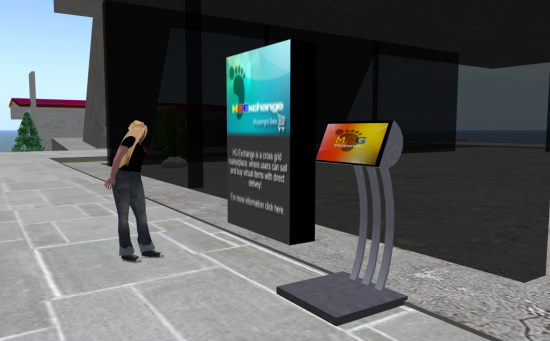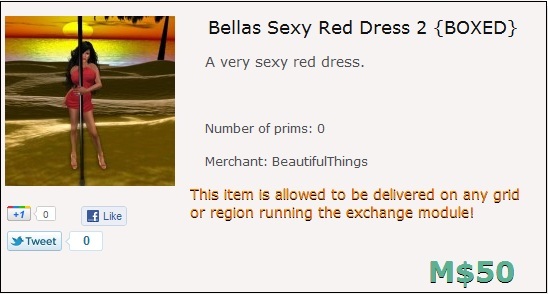If you’re launching a new grid, your number one problem is lack of content. Whether your grid is a corporate office complex for your employees, a campus for your students, or a large social and roleplaying world for your residents, they all need clothes, skins, hair, shoes, furniture, productivity tools, house plants, and about a zillion other things.
You could have your users upload content on their own from such places as OpenSim Creations or the FleepGrid Shop, or make everything from scratch. (People can also export their own creations from Second Life — as long as they are the creator of each item and all its constituent parts.)
But wouldn’t it be nice to put up an in-world vendor that displays content from the SL Marketplace and have your users get whatever it is that they want? Well, the SL Marketplace doesn’t deliver to OpenSim grids — yet. As the OpenSim universe grows, that policy may change — after all, why shouldn’t the Lindens take a cut out of OpenSim transactions as well, not just Second Life ones?
But there are two online marketplaces that do deliver to OpenSim grids — Cariama and HGExchange. Here’s how the two systems compare, head-to-head.
Installation
If you want these marketplaces on your grid, you will need to contact the owners.
For Cariama, contact founder and CEO Stephane Kieger at kay@cariama.com (he goes by Kay Noble in-world). He’ll do an audit of your grid, and set you up with the scripts you need for the vendors and terminals.
If you want a fully functional vendor system, you’ll need to be running a closed commercial grid — no self-hosted regions, no OAR or IAR exports for your residents. Open grids can only use Cariama as a place to showcase their items, with links to in-world stores.
For HGExchange, request an HGExchange module license, and install the module on all the regions that will be enabled to work with the HGExchange. The license currently costs a nominal $1.99. More information about the module is here. HGExchange modules are currently available for the standard distribution of OpenSim, for the Diva Distro, and for Aurora-Sim.

Any grid — commercial, open, even small grids owned by schools, companies, or individuals — can use the HGExchange marketplace. That doesn’t mean that every product by every merchant will be available in all the grids — it’s up to the merchants to decide where they want to distribute their items. The $1.99 module fee is a way to confirm that the grid owners are in good standing with PayPal — a way to screen out unscrupulous operators.
Both Cariama and HGExchange can also be installed by individual region owners — though they should check that the marketplaces don’t violate their grids’ terms of service. For example, Avination prohibits Web-based sales, and Cariama can only used to showcase products and point visitors to in-world shops.

“Cariama is easier to set up,” said Kai Ludwig, owner of German OpenSim hosting company TalentRaspel virtual worlds Ltd. and manager of the Wilder Westen and OpenNeuland grids, who is in the process of installing both marketplaces.
With the scripts, there is nothing at all for the grid owner to do. With the module, the grid owner has to modify the OpenSim server setup by adding the server-side module.
Security
According to HGExchange owner HGExchange owner Jefferson Costella, the module approach is more secure because the module is locked down, proprietary code — nobody can open it up, look the software, and figure out a way to hack into it.
But for TalentRaspel’s Ludwig, the fact that it is locked down just adds to his worries, since he can’t personally examine the code to check that everything is done right.
“This worries me a bit and I may kick HGExchange out of my setup if my customers start to complain about the possible security issues that this concept may bring with it,” he said.
“There is no security by obscurity,” he added.
He prefers the open source modules like the OMC or scripted vendors, terminals and advertising boxes that Cariama uses.
“Because they do not depend on inworld currency they manage all transaction on their website and only trigger the delivery after purchases have been made in the web interface,” he said. “So no direct interaction with the grid or region database or grid or region server is made. I prefer this approach, as it is open for code review, brings enough functionality, has a proven concept and does not need any binary [proprietary code] modules.”

But, according to HGExchange’s Costella, a script-based system is too vulnerable to interference.
“Everything that’s script based gives me the creeps,” he said. “I don’t trust it.”
According to Cariama’s Kieger, the only people who can get into Cariama scripts are the grid owners, since the Cariama vendor system is not available to open grids like OSGrid and New World Grid, which allow third parties to connect regions. That means that individual region owners don’t have access to the underlying OpenSim databases, said Kieger.
“So script hacking is not an issue for Cariama,” he said. That doesn’t mean that open grids are completely locked out of Cariama, he added — they can still use the marketplace to showcase products and to provide direct teleport links to in-world shops.
“The question to ask here is the following: ‘Are merchants willing to sell products in grids in which the region owner can export an OAR or IAR file?'” asked Kieger.
The HGExchange response? “When you publish an item [as a merchant], you have a choice of grids for delivery,” said Costella. “You can deliver to OSGrid, or to MyOpenGrid, or choose ‘Allow All Grids.'”
Merchants decide which grids can get their items. They can limit delivery to just the closed grids, for example. As the number of grids in the system gets larger, merchants will be able to, with one click, select all closed commercial grids, or private company grids, he added.
(OSGrid, a non-profit, does not officially endorse any currency or third-party marketplace system.)
Multi-grid vs. cross-grid
The other advantage of installing a module is that users can buy items created by merchants on other grids.
The HGExchange system is a true cross-grid platform, Costella said. A merchant on any of its supported grid can sell to the residents of any other grid they choose — or all other grids – or to just the closed, commercial grids on the platform.
The module could also deliver items to users who are on other regions — or who are logged off. That functionality will be added next, after PayPal support, Costella said.

Another advantage of the HGExchange system is that if a grid ceases operations — as recently happened with Meta7 — users will be able to get access to their purchases on another grid, if delivery to the second grid has been approved by the merchant.
“The items will still be in your marketplace account,” said Costella. “You can have them delivered to your avatar on another grid.”
The Cariama system is a multi-grid platform in the sense that it showcases items from multiple grids. But a merchant on one its supported grids can only sell to the residents of that same grid. If a merchant wants to sell to a second grid, they need to set up shop on the other grid, as well.
As a result, residents of some grids have extremely limited selections — Sim World shoppers, for example, have just 16 items to choose from. There are only 31 items available for 3rd Rock Grid shoppers, and 17 items for UFS Grid. On the plus side, InWorldz residents have more than 1,300 items to choose from on Cariama. (The bulk of items are available for sale only in Second Life.)

Currency support
The Cariama platform uses whatever currency a grid already has. If a grid has no currency, then the system uses Cariama’s internal currency for transactions, and users must pay a 10 percent conversion fee to convert L$ into it. In the future. Cariama plans to offer direct currency purchases on its website via PayPal, but this isn’t available yet.

The HGExchange platform currently uses MyOpenGrid’s M$ currency. Grid owners who don’t have a currency system in place can, if they wish, adopt the M$ currency. That is what the start-up Haven grid is doing.
“The currency system they’ve got, we tested it today, and it’s working perfectly,†Cheryl Shaw, co-founder of the Haven: Your World grid, told Hypergrid Business earlier this month. “If we can get everything in one place, we find that’s best.â€
HGExchange plans to offer PayPal support as well, and possibly OMC support after that. The OMC currency, from Austrian virtual currency exchange Virwox, is currently accepted on 28 OpenSim grids plus Second Life.
Fees and commissions
The Cariama exchange does not charge any fees for transactions. However, there is a 10 percent commission on currency exchanges.
That means that if a grid has its own currency, and a merchant sells goods in that currency, then there is no fee at all for the sale. However, if a grid doesn’t have its own currency then the buyer has to pay a commission to transfer funds into the Cariama C$ currency and then the merchant has to pay a commission to transfer money out of the C$ currency afterwards.

Cariama also makes money by selling advertising on its website. According to Kieger, revenues are currently divided evenly between currency exchange commissions and advertising.
HGExchange makes its money on transaction fees — 10 percent per transaction. There is no charge for posting freebies, and no charge for currency conversions.
Not mutually exclusive
There is nothing keeping a grid owner from adopting both platforms. And there are no costs associated with it — other than HGExchange’s $1.99 one-time module fee.
“I’ll continue to run both marketplaces,” said TalentRaspel’s Ludwig, who said that he will wait and see how his grid residents like the two platforms.
“As long as running a usefull technology won’t kill my reputation or my wallet I’ll stay with it,” he said.
He would like to see both exchanges support common existing payment options, he added.
“When will they support an established standard like OMC instead of creating one YAC$ — Yet Another Currency — after the other?” he asked.
By the numbers
Of course, what really matters to buyers is how much stuff there is on the exchanges that they can buy. Today, the answer is “not much at all.” Cariama, although it has been around since late 2009, has not been actively marketed or promoted by its founder. And HGExchange has only gone live this month. But for those interested anyway, here are the current statistics:
| Cariama | HGExchange | |
|---|---|---|
| Grids | Six grids: 3rd Rock Grid, Avination, InWorldz, Open Neuland,  Sim World, UFS Grid | Five grids: OSGrid, MyOpenGrid, Haven, AnSky, Nova |
| Users | 437 | 46 |
| Merchants | 345 | 35 |
| Available Items | 6,071 | 52 |
| Regions | 46 | 41 |
- OSgrid back online after extended maintenance - April 16, 2025
- Analysts predict drop in headset sales this year - March 25, 2025
- OSgrid enters immediate long-term maintenance - March 5, 2025
